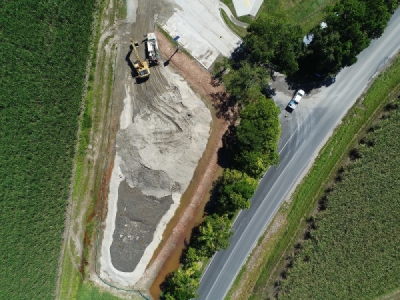
Posted on April 8, 2019
About 9000 cubic metres of sand dredged from the Daintree River will be spread across Newell Beach in an effort to fight erosion and damage to the shoreline caused by storms over the last three years.
The sand may initially be discoloured and stand-out from the sand already on the beach but Council is confident natural processes such as sun and wave action will clean it up relatively quickly.
The ferry channel is usually dredged once a year but has been dredged twice this year due to flooding in the Daintree River.
It has been three years since Council placed 35 geotextile bags filled with sand on Newell Beach and put around 7,000 tonnes of material between the groynes.
The first trucks of sand were delivered to Newell Beach yesterday and the restoration works are expected to continue for about a week.
There will be increased trucks movements on Newell Beach Road and residents at the intersections of Rankin and Newell Streets; Cyril Close and Newell Streets and those on the Esplanade from Newell Street south, will notice increased truck movements and may hear noise from plant and equipment operating on the beach to spread the sand.
The works reflect the objectives and direction of the Council’s draft strategic plan for resilient coastlines which is open for public consultation until 21 April.
Douglas Shire Council Mayor, Julia Leu, said the draft plan clearly defines the steps Council needs to take to ensure the region’s coastlines can withstand weather events and other damage for the long-term.
“The strategic plan’s recommendations reiterate the need to protect our foreshore vegetation from threats such as illegal tree clearing,” she said.
“Douglas Shire is in a fairly strong position when it comes to coastal hazard resilience and this is due to our efforts to protect our foreshores.
“Our experts talk about the benefits we get for our coastline by protecting ecosystems, rainforests, and tree canopies – especially those densely vegetated areas on our foreshores.”
Council’s Sustainability Officer, Nicola Learmond, said encouraging natural vegetation and restoring lost structures is integral for coastline resilience.
“A well-vegetated dune system is still the best form of protection from coastal hazards to the residential zones,” she said.
“People we spoke to generally felt that dune protection and land-use planning were the most suitable adaptation options for their local beach.”
Mayor Leu called on residents from across the shire to have their say on the plan and help drive Douglas Shire’s shoreline protection works.
“I encourage all residents, especially those living in our coastal communities, to read the draft strategic plan and give your feedback to the Resilient Coast project team,” she said.
Residents can provide feedback on the Coastline Resilience Plan until 21 April online and via email.
Source: newsport.com.au





